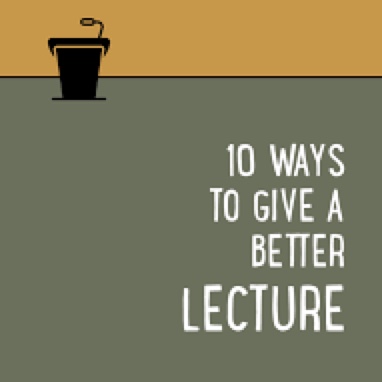10 Ways to Give a Better Lecture
Introduction
Mostly due to overuse and poor execution, lecturing has come to be frowned upon in modern teaching. It’s true that students should be active in their learning as much as possible and that we should create opportunities for inquiry learning, cooperative learning, project-based learning, etc. It’s also true that there is a time and a place for lecturing, especially if it is done well.
Lectures are a good fit when:
- The background information is not available or accessible to students
- The content may be confusing (and therefore need explanation)
- The teacher’s expertise will help make the material more clear
- The material needs to be delivered quickly
Along with using lectures more selectively, we need to make sure the lectures we do give are good. Here are 10 ways to improve the content and delivery of your lecture material:
10 Ways to Give a Better Lecture
1. GIVE IT STRUCTURE
Even if a lecture isn’t particularly exciting, it’s important to make it easy to follow. Do this by giving your presentation a clear structure and communicating that structure to your students.
2. KEEP IT BRIEF
Attention spans are short so to keep your students engaged, don’t talk for more than a few minutes at a time. This can be accomplished by only planning a short lecture to begin with (5 to 10 minutes) or by breaking up a longer lecture into shorter chunks, with interactivity in between those chunks.
3. ENGAGE YOUR AUDIENCE
In between those short stretches of teacher talk, you can do all kinds of things to get students participating and also sneak in some formative assessment. Whole class polls, small group discussions, and tools like Nearpod or Peardeck can be useful here.
4. USE VISUALS
Adding some kind of meaningful visuals to support your lecture will help students understand and remember what you teach. People just learn better when words are combined with images; this is the theory of dual coding, and it’s supported by decades of research. Your visuals can be any combination of charts, graphs, photos, or physical models. But we’re not talking about decoration here; they have to contribute to student understanding of the material.
Slides are a perfectly good way to add visuals to a presentation, if you do them well. The Cult of Pedagogy post Let’s Make Better Slideshows is dedicated entirely to specific principles you can follow to do just that. If the visuals you’re using are complex, it may also make sense to let students watch you create them piece by piece, rather than present their finished form on a slide.
5. USE EXAMPLES
You can explain something till you’re blue in the face, but until you provide an example of a concept, your students are much less likely to really get it. And more is better on this one, because as students are exposed to different examples of the same idea, their understanding becomes more refined.
6. USE ANALOGIES
Along with examples, analogies can make an abstract idea come to life. Comparing some new thing they’re learning to a thing they already know can often be the fastest way to help students understand something.
7. TELL STORIES
Stories create new mental images and strong emotional responses in listeners, and they provide a familiar, non-threatening way to ease students into learning. So whenever you can include a captivating story as a way to teach some part of your content, do it.
8. THINK OUT LOUD
As you give a lecture, it can be incredibly helpful if you verbalize your thinking process along the way. This is especially true if you are demonstrating some kind of process or skill, like solving a math problem or drafting a piece of writing, but it even works when you’re explaining a set of facts. If you come to a place that is often confusing to students or that even confused you once upon a time, take the opportunity to share that confusion with students; it will not just clear up their misunderstanding, but it will also reassure them that feeling uncertain is a normal part of the learning process.
9. MAKE IT DYNAMIC
You’ll hold students’ attention better if you make a concerted effort to mix things up. To emphasize a point, pause, lower your voice dramatically, or go up sharply in volume. Add physical interest by moving to different parts of the room while you speak, using memorable gestures to accompany certain points, or just being more expressive with your face. Activate emotions by inserting humor, personal details, or weird or surprising facts. And plan these moments: Instead of just generally aiming for a more dynamic presentation, actually mark places in your lecture notes where you plan to include these elements.
10. MOVE IT TO THE END
Lectures typically deliver the direct instruction piece of a lesson, the part where we are directly teaching our students something. And in a traditional lesson, that direct instruction happens at the beginning: We teach our students something, then they do something to apply the knowledge they just got. If we move things around — giving our students an opportunity to wrestle with the content a little bit first, then providing some direct instruction through a lecture — we stimulate their curiosity, get them thinking about the material more deeply, and create a context in which to fit the information they are about to learn. Then when we begin the lecture, students are much more invested in it.

